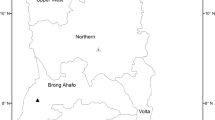Abstract
Rhaponticum repens (L.) Hidalgo is a clonal Asteraceae plant native to Asia and highly invasive in North America. We conducted open-field experiments in Iran to assess the impact of the biological control candidate, Aceria acroptiloni Shevchenko & Kovalev (Acari, Eriophyidae), on the target weed. Using three different experimental approaches, we found that mite attack reduced the biomass of R. repens shoots by 40–75 %. Except for the initial year of artificial infestation by A. acroptiloni of R. repens shoots, the number of seed heads was reduced by 60–80 % and the number of seeds by 95–98 %. Morphological investigations of the mite complex attacking R. repens at the experimental field site revealed that A. acroptiloni was by far the dominant mite species. We conclude that the mite A. acroptiloni is a promising biological control candidate inflicting significant impact on the above-ground biomass and reproductive output of the invasive plant R. repens.




Similar content being viewed by others
References
Callaway RM, Schaffner U, Thelen GC, Khamraev A, Juginisov T, Maron JL (2012) Impact of Acroptilon repens on co-occurring native plants is greater in the invader’s non-native range. Biol Invasions 14:1143–1155
Chetverikov PE (2012) Confocal laser scanning microscopy technique for the study of internal genitalia and external morphology of eriophyoid mites (Acari: Eriophyoidea). Zootaxa 3453:56–68
Chetverikov PE, Cristofaro M, de Lillo E, Petanović RU, Schaffner U, Vidovic B (2012) New taxonomical data on Aceria acroptiloni (Acari, Eriophyoidea), a potential biological control agent of the weed Acroptilon repens. In: Dimitriev AV, Egorov LV, Sinichkin EA (eds) Proc. II Int Conf Comm Professor M.A. Kozlov « Modern zoological studies in Russia and adjacent countries ». Novoye vremya Press, Cheboksary, Russia, pp 145–146
Chetverikov PE, Cvrković T, Vidović B, Petanović RU (2013) Description of a new relict eriophyoid mite, Loboquintus subsquamatus n. gen. & n. sp. (Eriophyoidea, Phytoptidae, Pentasetacini) based on confocal microscopy, SEM, COI barcoding and novel CLSM anatomy of internal genitalia. Exp Appl Acarol 61:1–30
Coombs EM, Clark JK, Piper GL, Confrancesco AF Jr (2004) Biological control of invasive plants in the United States. Oregon State University Press, Corvallis, USA
Djamankulova G, Khamraev A, Schaffner U (2008) Impact of two shoot-galling biological control candidates on Russian knapweed, Acroptilon repens. Biol Contol 46:101–106
Kovalev OV, Shevchenko VG, Danilov LG (1974) Aceria acroptiloni sp. n. (Acarina, Tetrapodili), a promising phytophage for the biological control of Russian knapweed (Acroptilon repens (L.) DC.). Entomol Rev 53:25–34
Müller-Schärer H, Schaffner U (2008) Classical biological control: exploiting enemy escape to manage plant invasions. Biol Invasions 10:859–874
Ni G-Y, Schaffner U, Peng S-L, Callaway RM (2010) Acroptilon repens, an Asian invader, has stronger competitive effects on species from America than species from its native range. Biol Invasions 12:3653–3663
Pearson DE, Callaway RM (2003) Indirect effects of host-specific biological control agents. Trends Ecol Evol 18:456–461
Rice PM (2013) INVADERS Database System. Division of Biological Sciences, University of Montana, Missoula, USA. http://invader.dbs.umt.edu
Schaffner U, Esch E, Cristofaro M (2013) Biological control of Russian knapweed, Acroptilon repens. Annual Report 2012. CABI, Delémont, Switzerland
Skoracka A, Kuczyński L (2012) Measuring the host specificity of plant-feeding mites based on field data - a case study of the Aceria species. Biologia 67:546–560
Smith L (2005) Host plant specificity and potential impact of Aceria salsolae (Acari: Eriophyidae), an agent proposed for biological control of Russian thistle (Salsola tragus). Biol Control 34:83–92
Smith L, DeLillo E, Amrine JW Jr (2010) Effectiveness of eriophyid mites for biological control of weedy plants and challenges for future research. Exp Appl Acarol 51:115–149
Sun Y, Collins AR, Schaffner U, Müller-Schärer H (2013) Dissecting impact of plant invaders: do invaders behave differently in the new range? Ecology 94:2124–2130
Urban AJ, Simelane DO, Retief E, Heystek F, Williams HE, Madire LG (2011) The invasive “Lantana camara L”. hybrid complex (Verbenaceae): a review of research into its identity and biological control in South Africa. Afr Entomol 19:315–348
Vidović B (2012) Taxonomic characterization of the species of the genus Aceria (Acari: Prostigmata: Eriophyoidea) associated with the plant species of the tribe Cardueae Cass. (Asteraceae). PhD Thesis, University of Belgrade, Serbia, 174 pp
Watson AK (1980) The biology of Canadian weeds. 43. Acroptilon (Centaurea) repens (L.) DC. Can J Plant Sci 60:993–1004
Zalucki MP, van Klinken RD (2006) Predicting population dynamics of weed biological control agents: science or gazing into crystal balls? Aust J Entomol 45:331–344
Zimmerman K, Kazmer D (1999) Distribution of Russian knapweed in the contiguous United States. Russian Knapweed Consortium 1999. Big Horn, Wyoming, USA
Acknowledgments
Financial support for this project was kindly provided by the Wyoming Biological Control Steering Committee, by United States Department of Agriculture -Animal and Plant Health Inspection Services – Center for Plant Health Science and Technology (USDA-APHIS-CPHST), and by Montana Weed Trust Fund, through Montana State University. This work was partly supported by a research grant from the Ministry of Science and Environment of the Republic of Serbia to R.P. and B.V. (Grant # III 43001).
Author information
Authors and Affiliations
Corresponding author
Additional information
Handling editor: John Scott.
Rights and permissions
About this article
Cite this article
Asadi, G., Ghorbani, R., Cristofaro, M. et al. The impact of the flower mite Aceria acroptiloni on the invasive plant Russian knapweed, Rhaponticum repens, in its native range. BioControl 59, 367–375 (2014). https://doi.org/10.1007/s10526-014-9573-z
Received:
Accepted:
Published:
Issue Date:
DOI: https://doi.org/10.1007/s10526-014-9573-z




